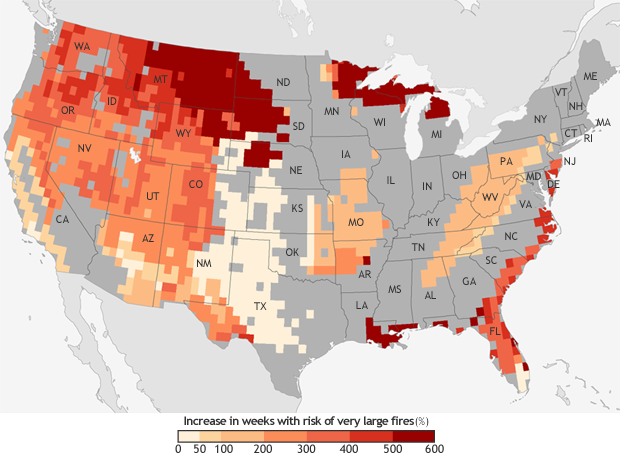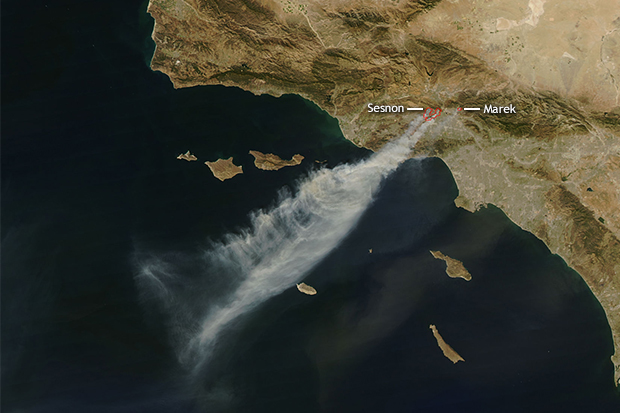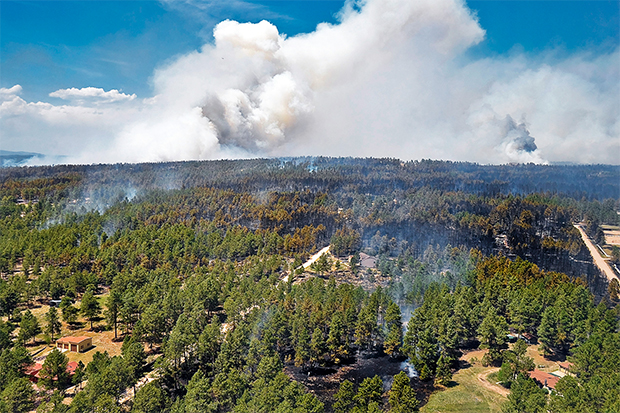Maintaining Good Indoor Air Quality Through Smoke and Wildfires
 [The projected increase in the number of “very large fire" weeks—weeks in which conditions are favorable to the occurrence of very large fires—by mid-century (2041-2070) compared to the recent past (1971-2000). NOAA Climate map, based on data from Barbera et al, 2015.]
[The projected increase in the number of “very large fire" weeks—weeks in which conditions are favorable to the occurrence of very large fires—by mid-century (2041-2070) compared to the recent past (1971-2000). NOAA Climate map, based on data from Barbera et al, 2015.]
Hospitals under fire
As wildfires encroach, hospitals can be forced to evacuate, even if the fire itself is not near the building. Hospital ventilation systems require a fresh supply of outdoor air to maintain indoor air quality and pressurization; if outdoor air is contaminated by heavy smoke, it may be impossible to safely house patients and staff in the building.
During wildfires, however, hospital emergency departments near the fire must remain operational to treat firefighters and affected community residents. To deal with smoke risks, hospitals in fire-prone areas can isolate emergency department ventilation systems and enable recirculated air during emergency conditions. In addition, portable air scrubbers or HEPA (high-efficiency particulate arresting) filters can be placed in various units to capture smoke, fumes, and airborne particles if outdoor ventilation systems must be shut down.
 [Driven by powerful Santa Ana winds, this NASA satellite image from October 13, 2008, shows smoke from the wildfires that raged near Los Angeles. Image courtesy NASA Earth Observatory.]
[Driven by powerful Santa Ana winds, this NASA satellite image from October 13, 2008, shows smoke from the wildfires that raged near Los Angeles. Image courtesy NASA Earth Observatory.]
A filter system saves the day
In 2008, southern California experienced two major wildfires: the Sesnon Fire in October lasted five days and the Sayre fire in November lasted six days. The Sesnon blaze posed a major threat to Providence Holy Cross Medical Center by engulfing the facility in smoke. Later, the Sayre fire was more intense, crossing a highway and preventing 40 percent of Providence’s staff from reaching the facility.
As it is the only local area trauma center in Burbank, Providence received more than 200 patients from neighboring hospitals and had to cancel all elective surgeries. Providence was able to stay open and operational through both fires, thanks in large part to its use of HEPA filters. The medical center had purchased these filters earlier for pandemic flu preparedness. The filters purify the air in a way that facilitates the central ventilation system maintaining zero pressures (critical for quarantine rooms). In this case, however, using the equipment for a different purpose enabled the hospital to remain open and functional during a fire event.
 [The Black Forest Fire burns near Colorado Spring in June 2013. U.S. Air Force photo by Capt. Darin Overstreet.]
[The Black Forest Fire burns near Colorado Spring in June 2013. U.S. Air Force photo by Capt. Darin Overstreet.]
The advantage of scrubbers
In June 2013, the Black Forest fire in Colorado forced the evacuation or pre-evacuation of approximately 300 employees of Memorial Hospital and Children’s Hospital Colorado from their homes. When Memorial Hospital received reports of the encroaching fire, the administrators immediately began preparing based on the hospital’s previous experience with the Waldo Canyon fire in 2012.
Memorial’s Safety and Facilities departments began “environmental rounds,” monitoring air quality in the buildings. The team placed portable air scrubbers at Memorial Hospital North, which was nearly full with patients, and at Memorial Hospital Central. Memorial worked with building managers at off-site locations to maintain air quality in those buildings through the fire.
Edited for WeatherNation by Meteorologist Mace Michaels